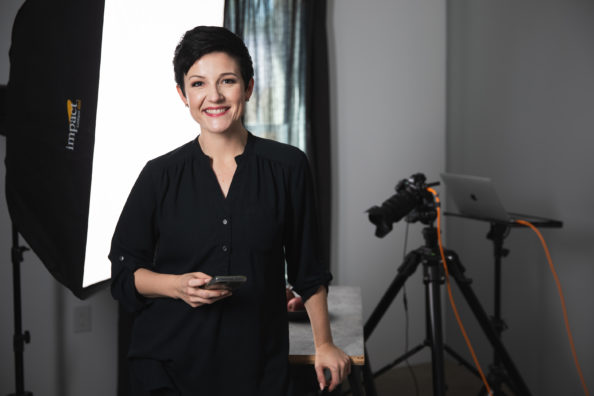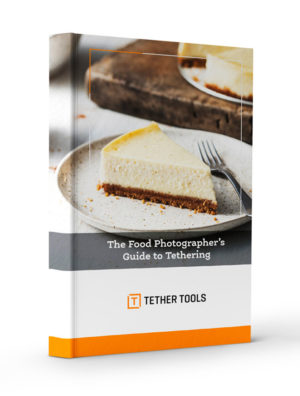
Before tethering, food photography came with several steps and a lot of risks. Missing the shot wasn’t an option because a reshoot meant more than simply setting up a tripod and some lights. With tethering, food photographers like me are not only able to prep the shot in advance, but we’re also able to check quality on the go and have our clients involved like never before.
Food Photography Tethering On-Site
A food photo shoot isn’t complete without tethering. Tethering is so embedded in my workflow that if you were to take it away, I would feel out of sorts. Having my gear connected and working together makes my life a lot easier because nothing drives me crazier than having to reshoot something. That’s the worst! Tethering is how I prevent reshooting from happening and save time in the long run.
Setup
On-site food photography starts with the setup. With TetherPro cables, my camera is connected to my computer for Live View so I can prepare the set before the food is placed in the shot. This allows me to capture the food at its best.
Quality
I like to shoot tethered on-site because then I know I have tack-sharp focus. The camera’s LCD screen is so small, and using the large display on my computer helps me fine-tune as I go, which improves the quality of my photos.
Communication
The ability to display photos as they are being taken from my Tether Table workstation invites the client to be a part of the process. In my opinion, Capture One is the best program for connecting with clients on-site. I’ll use my TetherPro cable to connect to Capture One on my computer so the client can view the images as they come in. This helps in so many ways because I am able to get real-time feedback while also setting expectations.
Power
Food photographers often work long shoots, and I don’t want to be interrupted to deal with batteries. This is why Case Relay with constant power is my favorite tethering tool. If you take it away, I get upset. When I’m plugged in to a constant power source, I am ready to rock all day long.
Food Photography Tethering in a Home Studio
I got my start photographing for my social media sites, and now I shoot from home for companies all over the world. Instagram food photography and flat lays aren’t going anywhere. Whether you’re shooting a cooking video or photographing a recipe, composition and planning are key to creating a successful image. Since I’m often working solo, nothing helps me prepare my home studio setup quite like tethering.
Versatility
The real power of tethering is in Live View. Nowadays, everyone is recording themselves behind the scenes for social media, and tethering your camera to your computer display helps establish strong composition. Also, when shooting for clients from home—especially editorial clients—I need to plan for negative space; Live View allows me to do this.
Marketability
If you’re starting like I did by shooting food photography for your social platform or blog, but you have ambitions to work with restaurants and food brands, tethering will allow you to connect with potential clients all over the world. For example, I was shooting a cookbook and the author was in Australia. I hired a local pastry chef to execute the recipes. We synced with the author and she was able to watch while we were shooting and ask us to tweak or change something.
Demand
Food photography inspires action, and no one needs more consumer action right now than the restaurant industry. With more and more people ordering meals and groceries online, the demand for quality food photography is overwhelming. Not to mention, many restaurants are reopening to guests for the first time after more than a year, and great imagery can help inspire reservations. Apart from ordering takeout, food photography sells magazines and cookbooks; it boosts a food brand’s presence on social media and improves the quality of a restaurant’s website.
Streamlining workflow with tethering changes the food photography game. It will help you produce high-quality, high-volume images while serving clients from all over the world. There are countless ways for you to get your foot in the food photography door, and the best part is, once you’re in, you’ll find that there are so many connections for growing your business.
Tether Tools Note: Don’t forget Mobility!
Hey in-home food photographers—remember that mobility is crucial. We recommend:
- Air Direct Wireless: move around your set without tripping on cables
- JerkStopper to protect your TetherPro connection
- Rock Solid Tripod Roller is perfect for tripod mobility
Download The Food Photographer’s Guide to Tethering for more insightful tips!
About Joanie Simon
Joanie Simon is a commercial food photographer and educator based in Phoenix, Arizona. She shoots for a variety of restaurants and creates crave-able images for food brands including their products in seasonally focused recipes. Self-taught, Joanie started in food photography as a food blogger. Visit her sites, The Bite Shot and JoanieSimon.com.




